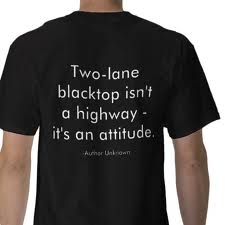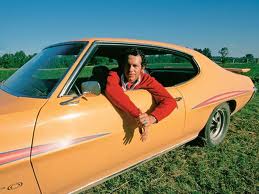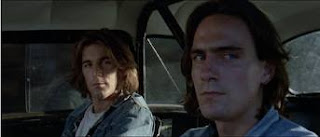Why was this in my classroom.
I remember looking at this illustration in like second
grade—footprints in the snow, getting wider and bloody and inhumanly wider
apart until they disappeared altogether.
When I was little everything gave me nightmares—like couldn’t
be in the room alone nightmares.
So my parents were pretty anxious to keep me away from anything
potentially frightening. Being
myself, I dedicated my young life to find and consume all the frightening
things possible. I was also a bright kid who’d finish her work early in school
so I’d be allowed to read in whatever reading corner we had.
That is how I finished the entirety of the “Scary Stories to
Read in the Dark” series over a couple months. They frightened me so much I don’t remember a lot (except
those weirdly...like...viscous illustrations) but they still have stuck with me in a kind of
protean form well into my adulthood.
But so here’s the actual story:
It was about two men out trapping. There was a blizzard that day, and that night the two men
huddled in their tent for safety. Then, something that sounded like the wind
called one of their names, over and over.
The man whose name was being called grew more and more agitated, until
he tore out of the tent running into the forest. The man left behind, after a few moments of disbelief and
fear at being left alone, ran after his friend. He could hear his friend’s voice in the distance, screaming,
“Oh my fiery feet! Oh my burning
feet of fire!”
He follows the voice and the footprints, until, like the
illustration suggested, they grew much further apart than any human stride,
until they disappeared—although, when the wind picked up again, he swore he
could hear his friend crying out the same phrase, but from far above him.
I figured out it was an adaptation of an old Algernon Blackwood story.
I'm including this illustration because it is 10000x less horrifying than the one in the kid's book.
He later finds his friend a pile of ash, and is informed that
his friend was taken by something called the Wendigo, a monster that “hurries
you along. Until your feet burn
away, and more of you than that.”
AAAAAAH.
This story is what came to mind after watching Two-Lane
Blacktop. Because they are
thematically related I feel.
STAY WITH ME.
The old pre-reinvented-as-cult-classic cover
Two-Lane Blacktop is a film made in 1971 by Monte Hellmann, starring
James Taylor, Warren Oates, Dennis Wilson, and Laurie Bird.
Also an inspiration for merchandise.
Stupid, stupid merchandise.
Its plot follows these two drag-racing dudes, the Driver and
the Mechanic, drag racing their way across America. They get into a feud with a guy known as GTO because that’s
what he drives. Along the way, the
Girl hitchhikes along with the two dudes.
The Driver’s Chevy and GTO’s GTO get their own place in the credits. It's that sort of movie.
This picture sums up everything about the movie relationship-wise.
The Driver and the Mechanic and GTO
agree on a cross country-race, which turns out to be the most codependent race in any movie
ever. They constantly swap cars,
people, parts, advice, help, etc.
The winner of the race gets the other car.
The Chevy in question. Knowing nothing about cars I'm assuming this is high-stakes.
But of course they never really make it to then end. None of them want to win. Because then they’d have to stop, once
they reached the ocean again.
They’d have to choose another place to head towards. It’s a sort of teleological despair
driving this. Or like, thanatotic,
if I can just keep throwing out Greek words.
James Taylor, with his unreasonably intense eyes, never cracks
a smile the whole time. Dennis
Wilson is every inch the Beach Boy.
Laurie Bird is (or seems) very, very young.
And they are all extremely shaggy the entire time.
And Warren Oates is a genius.
Which is not evident from this picture but trust me.
And it just follows them on the road. This movie was made
before the interstates, which means every drive is lonely and scenic, the cars
taking the many winds and turns much too fast. There’s no exit ramps; the cafes and motels and gas stations
are all on the road with them.
A lot of the movie is POV shots from a particular seat in the
car. And one could say that well
of course it is like all of the movie takes place in cars and they have to put
the camera somewhere. You’d be
right. But also Hellman uses those
shots pretty brilliantly.
He's beating you! You're the worst navigator ever.
No character ever talks about their backstory—where they come
from, where they’re going, what they enjoy, what they dislike. Except for GTO. A number of times he is seen picking up
hitchhikers and engaging with them in a very surface, bright,
desperate-Mamet-male joviality. He
tells a different story about his history every time. The camera is always POV passenger seat of the car, as if
the audience was the hitchhiker, and you watch GTO relate the stories
unsolicited with growing enthusiasm and an absurd amount of detail, often
turning his face and looking into the camera with a smile.
The only time GTO is not allowed to finish one of his sob
stories is when he tries to tell it to the Driver. He is immediately and curtly cut off by the Driver:
--I don’t what to hear about it.
--What do you mean, you don’t want to hear about it?
--It’s not my problem.
These sorts of details are not only irrelevant to the Driver
but actually kind of infuriating.
James Taylor does not care about your stupid life. He'll give you the side-eye.
--I go fast enough.
--You can never go
fast enough.
GET IT DO YOU GET IT.
This makes it sound terrible; like every stoner cult movie
ever. It is not.
It is wonderful.
And I say that as a person whose favorite movie involving cars
is “Crash.” Road movies don’t
really do it for me because 99% of them ARE about seeking to immerse oneself in
the projected zeitgeist or whatever.
(Even though I do respect them for kind of being a peculiarly American
medium.) But so usually they’re all about
finding yourself or your place or whatever.
Two-Lane Blacktop is a movie about desperately trying to lose
yourself—to go so fast you burn up.
Hanging around being lanky was not doing it for them.
This is not a movie you can watch while doing anything else. It evokes almost a trance—the weird
dreamy fugue state that occurs after more than about six hours on the road. The best moments are not set up by
music or narrative—they just occur.
Like at the end, the resigned way the girl drops her bag of possessions
that won’t fit on the motorcycle of her new companion. Or the bedraggled loneliness of the town they stop in to do repairs.
The closest the movie gets to really revealing anything is the
heartbreaking conversation GTO has with the Girl. She’s asleep, but that is fine for GTO who as ever is mostly
talking to himself.
“We’re gonna go to Florida,” he tells her. “And we’re gonna lie around the beach,
and we’re just gonna get healthy.
Let all the scars heal.
Maybe we’ll run over to Arizona.
The nights are warm. The
roads are straight…and we’ll build a house. Yeah! We’ll
build a house….”
He trails off, murmuring, “Cause if I’m not grounded very soon
I’m gonna go into orbit.”
Spoiler: they do not build a house in Arizona.
But really, much like how the beginning/ending monologues in
Trainspotting compose sort of a microcosm of the whole thing, the ending of
Two-Lane Blacktop sums up the whole movie:
To be honest I hated this when I first saw it, because, OMG,
seriously? But I’ve completely
come round.
I looked up Hellman’s motivations for the end, and he said he
considered it a movie about speed and wanted the audience to be conscious of it
as literally a film about speed—it went so fast it burned up. He’s fulfilling his Driver’s wish to
dissolve and burn up into pure speed and infinite road. As someone else pointed out, the burn
of the image begins in the Driver’s head.
Honestly I found this movie more affecting this last time then
the first time I tried to watch it.
Some time ago around this date something really terrible
happened to me. (I think a lot of
us have things like that in our lives.)
When I try to gauge how far I’ve come since then, it doesn’t seem like
I’ve moved at all. No matter how
hard I work it’s all still there a couple of neurons away.
It’s an engaging fantasy that you can ever really escape
yourself—that you can go fast enough—until
your feet burn away and more of you than that.
Of course what is more probable is that I really should not
have read all those scary stories as a kid.














No comments:
Post a Comment